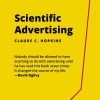Scientific Advertising: 21 advertising, headline and copywriting techniques
£3.70
Understand and use the concepts of successful advertising
Whether you are considering a career in advertising or trying to find the best way to market your product, start with Hopkins and then move onto the rest.
In this powerful book he explains the process to get (and measure) results from your advertising.
Claude Hopkins wrote ‘Scientific Advertising’ in 1923, but his insight into consumer behaviour still holds. The aim was to explain the rules of advertising and what makes consumers buy, so that advertising returns would become a certainty and not a guess. Learn how to use his techniques to write adverts which sell with certainty.
Hopkins clearly shows how to write copy, provides methods for testing it and shows how evidence based advertising gets results in a measurable and cost effective way.
A must read if you are in business, sales or advertising. Hopkins shows what makes us buy and how you can make it happen.
This edition also includes examples of adverts produced by Claude Hopkins through his career.
Nobody should be allowed to have anything to do with advertising until he has read this book seven times. It changed the course of my life. David Ogilvy
Within this book Hopkins shows a variety of tested techniques which he had used through his successful career in advertising, including:
- How advertising laws are established – What the professionals in advertising already know and how we can use this knowledge to develop better ads.
- Just salesmanship – What is advertising and how is it best used?
- Offer service – The best ways to offer service to increase sales.
- Mail order advertising – What it teaches us and how we can apply it to our own adverts.
- Headlines -A lot of headlines get a poor response in email marketing, websites and adverts. Learn how to increase your response rate.
- Psychology – Use Hopkins experience to direct people to buy and use your product.
- Being specific – Are you being specific enough in your advertising? Hopkins shows that by using specific facts you can increase sales and out perform your competitors.
- Tell your full story – How telling your story is important and why some advertisers make the mistake of missing out on this.
- Art in advertising – Should we use bespoke artwork or tried and tested visuals?
- Things too costly – What strategies are too costly to attempt in advertising.
- Information – How to give the consumer the best information to help them buy.
- Strategy – Rules for directing a campaign.
- Use of samples – How getting samples into peoples hands can increase sales.
- Getting distribution – Hopkins lays out how to get national distribution by starting small.
- Test campaigns – How to test different campaigns on the same audience.
- Leaning on dealers – Ways to get dealers to help your campaign
- Individuality – Set yourself apart from competitors and what your tone should be.
- Negative advertising – Will it help your sales?
- Letter writing – Hopkins shows how to write a sales letter.
- A name that helps – How does a product name impact sales?
- Good business – See how good business impacts on consumer behaviour.
Excerpts from the book
The only purpose of advertising is to make sales. It is profitable or unprofitable according to its actual sales.
I never ask people to buy. The ads all offer service, perhaps a free sample. They sound altruistic. But they get a reading and action. No selfish appeal can do that.
I set down these findings solely for the purpose of aiding others to start far up the heights I scaled.
Read more
Additional information
| Publisher | 1st edition (30 Aug. 2015), CreateSpace Independent Publishing Platform |
|---|---|
| Language | English |
| Paperback | 126 pages |
| ISBN-10 | 1517038073 |
| ISBN-13 | 978-1517038076 |
| Dimensions | 13.34 x 0.64 x 20.96 cm |







by D. Powell
Bought this book after a recommendation and it has proven a very interesting read. Only reason for the 3-star review is the quality of the product itself rather than the content. The book is now public domain but I assume the original pictures may be covered under a different copyright law and are therefore not included. This means that where the book refers to a particular advertisement they are actually not present. I’m sure they’d be fairly easy to track down online though but the same could be said for the book itself. Also there are quite a few typos which leads to a little bit of re-reading of lines in order to work out what they are supposed to say. Definitely worth reading if you are starting out or want to brush up on your advertising knowledge and as other reviewers have noted, it’s amazing how relevant much of the content remains even in the digital age.
by Tham Chee Wah
Although some ideas are out of date, there are still plenty of good advice.
There are a few thoughts of good advertising practices that we can take note of. Even in this age where social media is considered by many to have helped raked in the sales, but attractive ad copies are still the draw. Get readers to take note and take action.
An extremely practical book for everyone, and who doesn’t sell?
by Keyser Soze
It may feel somewhat a little dated because of the examples etc., but the principles explained are good fundamentals. I would like to see a refreshed edition, perhaps more in sync with the age of data but what do I know.
by John Penfold
The author assumes that you you know the old lingo, freely talking about “split runs” and “traced returns”. I had to look up a few of these.
The tone is a little dogmatic at times, but for some reason that did not irritate me. I guess that Hopkins impressed me enough with his superior knowledge that I allowed him that.
Much of this stuff still seems relevant today, II kept thinking “That’s also true for for advertising copy in ebay and facebook”.
In common with other authors in the advertising industry, Hopkins portrays advertising as a beneficial service for consumers, rather than a tool to persuade us to buy stuff against our better judgement. In fairness,, Hopkins does focus on giving us reliable and accurate information from the manufacturer so that we can make our own decision, rather than using “Hidden Persuaders”.
by 3agle 3yes
This is an old book, but many of the principles can still be applied today. The big takeaway? Always continue to test your ads, even when they’re doing well…because they can also do better.
by Catalin Vlad
This is a must read book, it just blew my mind of all the techniques used in advertising, and how everything serves a purpose.
I highly recommend to read it, it’s a short book can be read in a couple of hours/days.
Great writing, straight to the point.
It’s a ⭐️⭐️⭐️⭐️⭐️ book !
by Cavatica_
The book is one of the great classics of marketing. However, this yellow paperback version, while it is very nicely laid out with high quality paper, has some typos that actually change the meaning of the text. One such example, this edition says:
The motto is “The more you tell the more you sell.” And it has never failed to be proven wrong in any test we know.
What Hopkins actually wrote:
The motto there is, “The more you tell the more you sell.” And it has never failed to be proven out in any test we know.
The typo gives the complete opposite meaning of what was intended.
by I. Krutainis
Replace Newspapers with Facebook in the text and you might think that you’re reading a post about 2021 Facebook ad strategies. Ok I’m over dramatizing, but this book is still delightfully relevant.